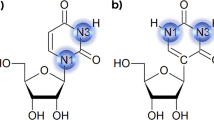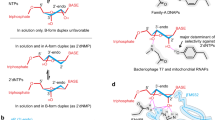Abstract
Conformational analysis of nucleic acids and polynucleotides is far more complex than that of proteins and polypeptides, due to five single bond rotations in addition to the sugar puckerings in the monomer. Sundaralingam1 proposed the concept of the ‘rigid’ nucleotides from analysis of crystal structure data, with the flexibility allowed only about the phosphodiester bonds. However, the crystal structure of deoxyguanosine-5′–phosphate2,3 indicates at gt conformation about the C-4′–C-5′ bond against gg in a conformationally rigid nudeotide1. Jack et al.4 considered the flexibility of nucleotides in tRNA about the C-4′–C-5′ bond, thereby introducing the concept of ‘non-rigid’ ribonucleotides. Conformational flexibility of the f uranose ring in DNA and RNA and their energetics using classical and quantum chemical methods have been reported5–8. We have examined the flexibility of 3′-nucleotides. α, the most important of the conformational parameters defining the 3′-end of a nucleotide unit9, has a value in the range 195°–270° in all the 3′-nucleotides, dinucleoside monophosphates and higher oligomers which have been surveyed. A survey of the proposed structures of polyribonudeotides10,11 also shows the values of a to be greater than 200°. However, the structures proposed for B-DNA by Arnott and Hukins12,13 and D-DNA by Arnott et al.14 have values of α of 155° and 141° respectively, much lower than the lowest observed value. The structure for B-DNA has two strong, short contacts (C-2′…OP-1 = 2.64 Å and HC-2″…OP-1 = 1.79 Å) which lead to an energetically unfavourable conformation. Hence, it is of interest to investigate whether, by allowing flexibility to the sugar moiety in the nucleotide unit, it is possible to make the structure energetically favourable. Here, conformational energy calculations were carried out to determine the range of α which would give rise to energetically favoured conformations with different sugar puckerings. Our analysis has shown that the theoretically obtained range is nearly the same as the preferred range in crystals, indicating the flexibility of the 3′-nucleotides.
This is a preview of subscription content, access via your institution
Access options
Subscribe to this journal
Receive 51 print issues and online access
$199.00 per year
only $3.90 per issue
Buy this article
- Purchase on Springer Link
- Instant access to full article PDF
Prices may be subject to local taxes which are calculated during checkout
Similar content being viewed by others
References
Sundaralingam, M. in 5th Jerusalem Symp. Quantum Chem. Biochem. (eds Bergmann, E. D. & Pullman, B) 417–455 (Academic, New York, 1973).
Young, D. W., Tollin, P. & Wilson, H. R. Nature 248, 513–514 (1974).
Viswamitra, M. A. & Seshadri, T. P. Nature 252, 176–177 (1974).
Jack, A., Klug, A. & Ladner, J. E. Nature 261, 250–251 (1976).
Levitt, M. & Warshel, A. J. Am. chem. Soc. 100, 2607–2613 (1978).
Pullman, B. & Saran, A. Prog. Nucleic Acid Res. molec. Biol. 18, 215–322 (1976).
Sasisekharan, V. in 5th Jerusalem Symp. Quantum Chem. Biochem. (eds Bergmann, E. D. & Pullman, B.) 247–260 (Academic, New York, 1973).
Pattabiraman, N. n, N. thesis, Indian Inst. of Science, Bangalore (1979).
Seeman, N. C., Rosenberg, J.M., Suddath, F. L., Kim, J. J. P. & Rich, A. J. molec. Biol 104, 109–144 (1976).
Arnott, S., Hukins, D. W. L., Dover, S. D., Fuller, W. & Hodgson, A. R. J. molec. Biol. 81, 107–122 (1973).
Arnott, S., Chandrasekharan, R. & Seising, E. in Structure and Conformation of Nucleic Acids and Protein-Nucleic Acid Interactions 577–596 (University Park Press, Baltimore, 1975).
Arnott, S. & Hukins, D. W. L. Biochem. biophys. Res. Commun. 47, 1504–1509 (1972).
Arnott, S. & Hukins, D. W. L. J. molec. Biol. 81, 93–107 (1973).
Arnott, S., Chandrasekharan, R., Hukins, D. W. L., Smith, R. S. C. & Watts, L. J. molec. Biol. 88, 523–533 (1974).
Lakshminarayanan, A. V. & Sasisekharan, V. Biopolymers 8, 475–488 (1969).
Sasisekharan, V. & Pattabiraman, N. Nature 275, 159–162 (1978).
Arnott, S., Dover, S. D. & /Wonacott, A. Acta crystallogr. B25, 2192–2206 (1969).
Marvin, D. A., Spencer, M., Wilkins, M. F. H. & Hamilton, L. D. J. molec. Biol. 3, 547–565 (1961).
Author information
Authors and Affiliations
Rights and permissions
About this article
Cite this article
Pattabiraman, N., Rao, S. & Sasisekharan, V. Is 3′-nucleotide rigid?. Nature 284, 187–189 (1980). https://doi.org/10.1038/284187a0
Received:
Accepted:
Issue Date:
DOI: https://doi.org/10.1038/284187a0
Comments
By submitting a comment you agree to abide by our Terms and Community Guidelines. If you find something abusive or that does not comply with our terms or guidelines please flag it as inappropriate.



